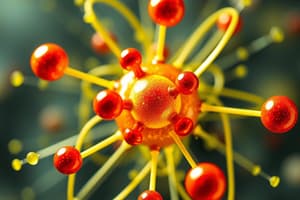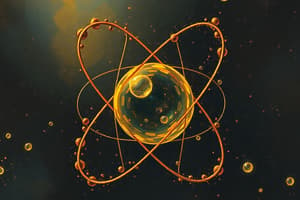Podcast
Questions and Answers
Where is most of the mass of the atom located?
Where is most of the mass of the atom located?
In the nucleus.
What subatomic particles does the nucleus contain? What is the charge of the nucleus?
What subatomic particles does the nucleus contain? What is the charge of the nucleus?
Protons and neutrons; positively charged.
What determines the size of the atom?
What determines the size of the atom?
Electrons.
What determines the size of the atom?
What determines the size of the atom?
Which experiment was responsible for determining the charge of the electron?
Which experiment was responsible for determining the charge of the electron?
What did Rutherford attempt to prove in his gold foil experiment?
What did Rutherford attempt to prove in his gold foil experiment?
In the Rutherford gold foil experiment, what happened to the positively charged alpha particles that were shot at the foil?
In the Rutherford gold foil experiment, what happened to the positively charged alpha particles that were shot at the foil?
What did Rutherford conclude based on the results of his experiment?
What did Rutherford conclude based on the results of his experiment?
Which model was Rutherford attempting to support with the gold foil experiment?
Which model was Rutherford attempting to support with the gold foil experiment?
What is the name of the force of attraction between subatomic particles in the nucleus?
What is the name of the force of attraction between subatomic particles in the nucleus?
What is the name of the force that is responsible for beta decay?
What is the name of the force that is responsible for beta decay?
What are the three subatomic particles in the atom?
What are the three subatomic particles in the atom?
What are the masses of the subatomic particles?
What are the masses of the subatomic particles?
What are the charges of the three subatomic particles?
What are the charges of the three subatomic particles?
During electrostatic charging by friction, which subatomic particle(s) is/are transferred between objects? Explain.
During electrostatic charging by friction, which subatomic particle(s) is/are transferred between objects? Explain.
Flashcards are hidden until you start studying
Study Notes
Structure of the Atom
- The nucleus holds the majority of an atom's mass.
- Protons (positively charged) and neutrons (neutral) are found in the nucleus, which is small relative to the size of the atom.
Atom Size
- The size of the atom is primarily determined by the arrangement and behavior of electrons within the electron cloud.
Key Experiments
- The Millikan oil drop experiment measured the charge of the electron.
- Rutherford's gold foil experiment aimed to validate the plum pudding model, which posited that atoms consist of negatively charged electrons dispersed in a positively charged medium.
Rutherford's Findings
- In the gold foil experiment, most alpha particles passed through the foil, but some were deflected and bounced back.
- This led Rutherford to conclude that the atom has a small, dense, positively charged center, disproving the plum pudding model.
Fundamental Forces
- The strong nuclear force binds protons and neutrons in the nucleus.
- The weak nuclear force is responsible for processes like beta decay.
Subatomic Particles
- Atoms consist of three subatomic particles: protons, neutrons, and electrons.
- Protons and neutrons have similar masses (approximately 1.6 x 10^-27 kg), while electrons have significantly less mass (about 9.11 x 10^-31 kg).
- The proton carries a positive charge, the electron is negatively charged, and the neutron is neutral.
Electrostatic Charging
- During electrostatic charging by friction, only electrons are transferred between objects; protons remain unchanged in the nucleus due to their strong binding.
Studying That Suits You
Use AI to generate personalized quizzes and flashcards to suit your learning preferences.




